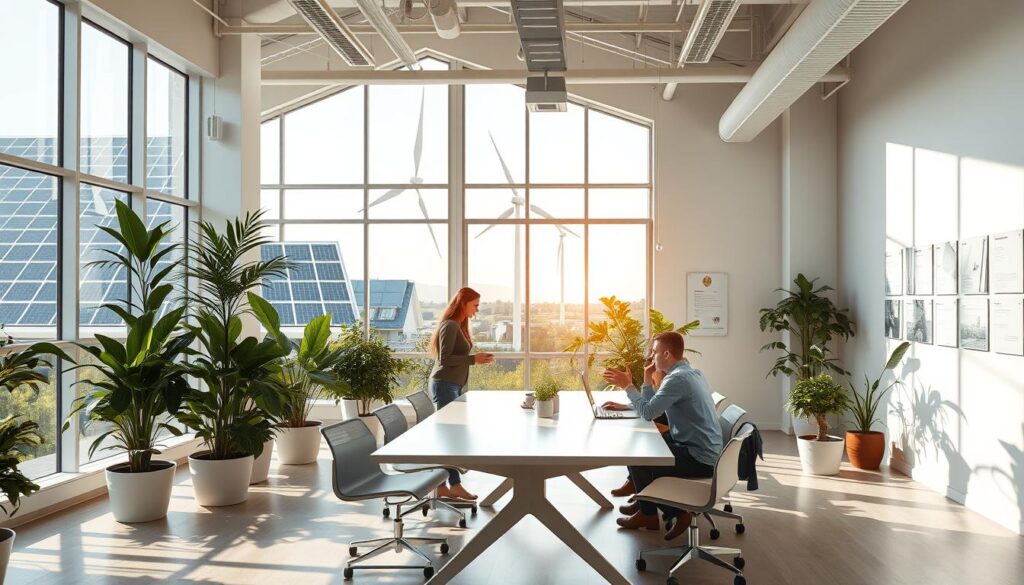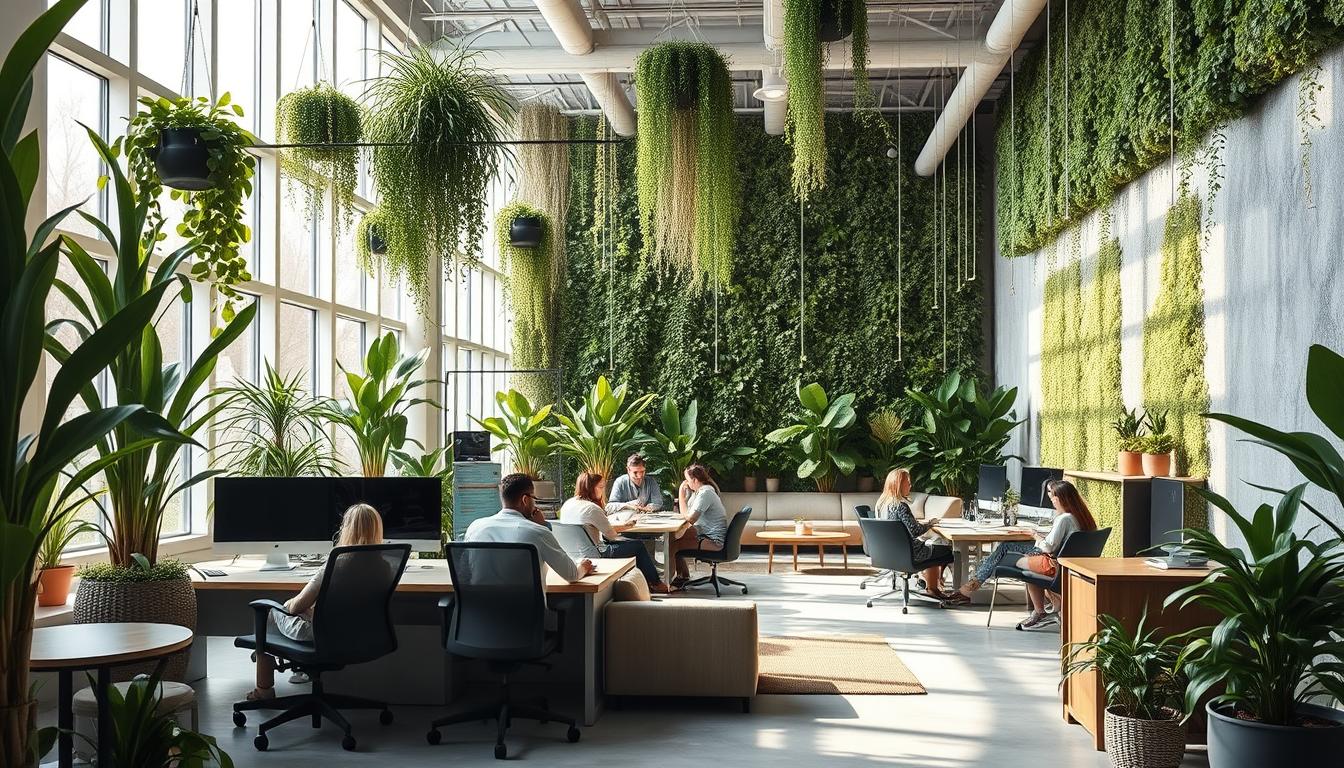Nowadays, being sustainable is key for any business. This guide explores how sustainability can fit into workplaces. It highlights why it’s important for companies to act responsibly and lower their carbon footprint. By adopting green-certified practices, businesses don’t just help the planet. They also boost employee happiness and work performance.
Understanding Sustainability in the Workplace
The need for sustainability at work is becoming more important for companies all over the world. With environmental concerns growing, businesses are pushed to cut down their carbon footprint. This effort helps them follow laws and meet the expectations of environmentally aware employees. Being sustainable is not just a choice anymore; it’s a key part of being responsible and creating a strong business reputation.
Importance of Reducing Carbon Footprint
Lowering the carbon footprint is essential for a healthier planet. Companies can do this in a few ways, like:
- Implementing energy-efficient technologies
- Encouraging remote work to lower commuting emissions
- Utilizing renewable energy sources
Every step a company takes can help improve the environment. This shows that when organizations focus on sustainability, they’re part of a bigger push for global health.
Corporate Responsibility and ESG Factors
Corporate responsibility is changing, especially when it comes to ESG (Environmental, Social, Governance) factors. Companies are judged more on how they deal with these aspects now. Focusing on sustainability and sticking to ESG standards shows a company’s dedication to doing business responsibly. Investors and other important people now look for business strategies that have a good effect on the environment and on society. Using ESG factors as part of business planning helps create lasting value and promotes a culture of taking responsibility.

Benefits of Green-Certified Workplaces
Going green at work has many benefits. It creates a healthier environment for everyone. Green offices focus on the health of workers. They use designs that boost mental and physical wellbeing. Being eco-friendly is now a big part of doing business right.
Enhanced Employee Well-Being
Green workplaces bring in fresh air, lots of sunlight, and natural designs. These things make workers happier and less stressed. Being close to nature helps people feel good. It’s really important for mental health at work.
Increased Productivity Through Sustainable Design
Design that thinks about the environment helps workers do better. A comfy and well-thought-out office makes people more focused. Studies show that people work harder and better in green places. This is great for business.
Potential Cost Savings
Green offices can save companies money. Using less energy and eco-friendly materials cuts costs. By going green, businesses not only save money but also look good. They show they care about the planet.
Green-Certified Workplace Environments: What You Need to Know
Companies today are striving to make their offices green-certified. This means they follow specific rules to lessen their environmental impact. They focus on saving energy, reducing waste, and using materials that are good for the earth.
Learning about green-certified workplaces starts with recognizing what makes a space green. It involves eco-friendly building practices, energy-saving features, and thoughtful workspace design. These decisions help create a better place for employees and the earth.
Making your workplace green enhances your company’s image. It also draws in employees who care about the environment. When green practices are part of daily work life, employees feel more connected and happy. This positivity spreads throughout the company and into the community.
Choosing the Right Green Certification
Picking the right green certification is key for businesses looking to boost their eco-friendly efforts. Setting SMART goals that match the company’s plan sets a strong base. These goals make it easier to stay on track and own up to eco responsibilities.
Defining SMART Environmental Goals
SMART goals are central to a winning green certification strategy. By setting clear, achievable aims, businesses can use their resources wisely. For instance:
- Reducing energy usage by 20% in five years.
- Hitting at least a 75% waste diversion rate in three years.
- Starting a company-wide recycling program in six months.
This focused approach lets companies monitor their progress and adjust as needed. It shows a strong commitment to caring for the environment.
Types of Certifications Available
Knowing the different green certifications out there is crucial for companies dedicated to sustainability. Some key ones are:
- LEED (Leadership in Energy and Environmental Design)
- B Corp Certification
- ECOLOGO
Each one has its own criteria and benefits, offering a guide for making real eco-friendly changes. Picking the right certification can line up with a company’s eco goals and boost its standing in the market.
Materials and Design Elements for Sustainability
Creating a workspace with a green certificate means using special materials and designs. These focus on saving energy and protecting nature. Here are some important areas to think about if you want to make your design sustainable.
Energy Efficient Lighting Solutions
Using lights like LED bulbs saves a lot of energy. They last longer and use less electricity than old-style lights. Smart lighting systems make this even better. They turn workplaces into environmentally friendly places.
Low-Emission and Recycled Office Materials
Choosing office supplies that are low in harmful emissions or made from recycled things helps avoid waste. Using reclaimed wood or recycled metal cuts down on harmful gases from making new materials. This way, offices are not just using resources smartly but also taking care of the planet and people’s health.
Eco-Friendly Office Furniture Options
Buying furniture made from things like bamboo or recycled plastic is good for the environment. Such furniture looks good and works well in office settings. Choosing these items means your office is working towards being more sustainable and making the workspace better for everyone.
Creating a Sustainable Office Space
Creating a sustainable office takes careful thought and creative approaches. Using eco-friendly design makes offices look better and helps workers feel good and work better. Having a good office design lets in natural light and improves air flow, making the space welcoming and healthy.
Office Layout and Designs That Promote Sustainability
Ways to make office layouts green include:
- Incorporating open spaces to facilitate natural airflow and light.
- Utilizing modular furniture that can be rearranged based on team needs.
- Integrating biophilic design elements, such as indoor plants, to boost air quality and enhance mental health.
Implementing Energy Management Systems
Managing energy is key for a green office space. Adding energy management systems helps businesses track and lower how much energy they use. These systems offer big benefits:
- Reducing energy waste through real-time data analysis.
- Identifying opportunities for energy efficiency improvements.
- Lowering operational costs through effective energy resource management.
Case Studies of Successful Green-Certified Workplaces
Real-life stories show how green workplaces greatly affect business. These cases teach us how new designs and green habits can help businesses care more for the environment. They also show ways to cut down on harming the planet.
High-Profile Companies Leading the Way
Big names have set the standards for being eco-friendly. Companies like Google and Tesla are examples of how green practices can lead to significant certifications. They’ve changed their offices to use less energy and keep employees healthy.
- Google’s main office uses cutting-edge green tech, like solar power and plenty of natural light.
- Tesla’s buildings use materials that show their dedication to protecting the environment.
Lessons Learned from Innovative Designs
Looking at these green workplaces, we find several key points. The design choices made are not just about looking good. They also serve a functional purpose of being sustainable. Here are some important takeaways:
- They design office spaces that encourage team work while also saving energy.
- They add lots of plants to improve air quality and make employees happier.
- They choose building materials that have a smaller impact on our planet.
Community Engagement and Corporate Responsibility
Creating a strong sustainability culture at work means focusing on community ties and corporate duty. Companies succeed by getting employees to join in on green projects. This effort boosts everyone’s commitment to keeping the planet healthy and shows the company cares about society.
Promoting a Culture of Sustainability
Businesses serious about sustainability encourage employees to share ideas and join green efforts. This teamwork underlines the value of working together. When employees can speak up, they come up with new ideas and support the company’s green goals more.
Employee Participation in Eco-Friendly Initiatives
Getting involved in green projects helps with corporate responsibility. Campaigns to reduce waste, plant trees, and save energy get everyone involved. These actions show the company is serious about the environment and improve its image too.
Common Green Claims You Should Be Aware Of
These days, many companies use green claims to show they care about the earth. But telling true efforts from greenwashing is hard. Knowing which certifications are real helps consumers and businesses tell them apart. They learn to see which claims and labels really mean something green.
Identifying Legitimate Certifications vs. Greenwashing
Distinguishing real certifications from greenwashing stops confusion and stops companies from fooling shoppers. True certifications give solid proof of a company’s green actions. Greenwashing, though, is about seeming eco-friendly without really being it. Always check the foundation of each certification, looking for known groups that check if environmental rules are followed.
Key Labels to Look for in Products
When looking for sustainable products and services, some labels give important clues:
- ENERGY STAR – Known for making appliances and buildings use less energy.
- ECOLOGO – Shows products are made with less harm to the environment.
- Green Seal – Tells shoppers about good eco-friendly practices.
Stay sharp about green claims brands make, making sure there’s real proof behind them. Always choose products with real environmental benefits.
Conclusion
The importance of sustainable workplaces is becoming more clear in today’s business world. Creating green-certified work environments is key to improving corporate sustainability. It shows a strong dedication to taking care of our planet, which employees and customers appreciate.
Going green also makes employees happier and more productive. People want to work for companies that care about the same things they do. When a business focuses on sustainability, it can keep its best workers and stand out in the market.
Moving towards sustainable practices is more than just a trend; it’s essential for lasting success. Businesses that understand and act on this will do well in a future where caring for the environment is crucial. By adopting these practices now, companies can help ensure a better world for everyone.



